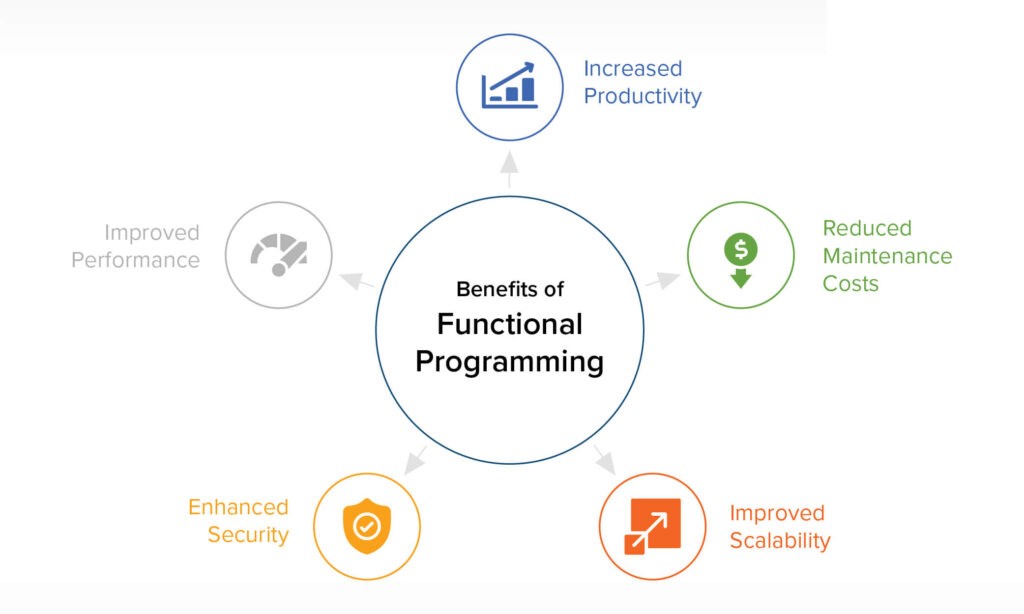Introduction: A Return to Software Design’s Origins
Functional programming (FP), which was formerly thought to be a specialized academic idea, has astonishingly returned to use in contemporary software design lately. With the advent of concurrent microservices and huge back-end procedures, architects and builders are reconsidering the structure of code. This trend is a calculated reaction to the increasing complexity, scalability, and performance requirements of contemporary systems; it is not merely a resurgence.
As we enter an era where clean code, concurrency, and predictability are more important than ever, functional programming offers a model that’s increasingly aligned with the future of development. Why is this occurring now, though, and what does it signify for the contemporary development stack?
Fundamental Principles of Functional Programming
At its heart, functional programming is a paradigm based on pure functions, immutability, and declarative code structure. FP encourages side-effect-free functions and stateless design in contrast to object-oriented programming (OOP), which is centered on objects and stateless interactions.
Among the fundamental ideas are

Immutability: After being defined, variables remain constant.
Higher-Order and First-Class Functions: Functions are interchangeable like variables.
Pure Functions: an input that consistently yields a distinct output.
Referential transparency allows functions to be swapped out for their output without affecting how the program behaves.
In today’s age of distributed systems and serverless architecture, those ideas translate to programming that has become simpler to test, debug, and parallelize.
The Reasons Behind Functional Programming’s Resurgence in Popularity (2025 Context)
The following contemporary trends and imperative approaches’ shortcomings are fueling FP’s resurgence:

1. Concurrency and Parallelism Needs
Thread-safe activities have grown difficult to manage with distributed computing and multi-core machines. The immutability and statelessness of FP lessen race situations and improve the maintainability of concurrent logic.
2. Functional Languages’ Ascent in Production
Functional components like Python and JavaScript (with libraries like RxJS and Ramda), as well as languages like Elixir, Scala, Haskell, and F#, are increasingly being used in critical systems.
3. Support for Functions in Common Languages
Even traditionally imperative languages are adopting FP principles. For instance:
With the help of the arrow, reduce, and map functions, JavaScript now supports functional programming.
Java introduced functional interfaces and lambda expressions in Java 8+.
Data processing makes extensive use of Python’s functools, lambda, and map/filter/reduce.
4. Better Code Reusability and Modularity
By its very nature, functional code is modular. Small, pure functions can be reused in a wide variety of contexts, boosting maintainability.
Practical Applications of Functional Programming
Reactive Systems and Architectures Driven by Events
Naturally, FP is a part of reactive programming. Function pipelines and stateless logic facilitate the management of systems such as message queues, real-time data streams, and observables.
Machine Learning and Data Transformation
Graph-based computations are used by libraries such as TensorFlow, which are quite similar to functional pipelines. Functional data manipulation, such as map, apply, and lambda, is the norm in R and Python.
Microservices and Serverless Development
Self-contained, stateless services are something that FP is in favor of. The microservice model, in which every service carries out a particular task on its own, is enhanced by this.
Functional Programming’s Benefits for Development Stacks
Predictability: Pure functions lessen side effect-related bugs.
Testability: Unit testing stateless components is simpler.
Concurrency: With contemporary CPUs, functional code scales nicely.
Adaptability: promotes the use of reusable and decomposable parts.
Decreased Insects: Immutability reduces state-related errors.
Difficulties and misunderstandings
Functional programming isn’t a panacea, despite its benefits.
Typical worries include: The learning curve: For newcomers, the paradigm shift could be challenging.
Verbosity: FP can occasionally feel verbose and abstract.
Debugging and Tooling: Tooling is less developed than in OOP ecosystems.
Overhead in Performance: Excessive function composition can impact performance if not optimized properly.
However, functional frameworks, hybrid paradigms, and contemporary compilers are assisting in bridging these gaps and increasing the usability and accessibility of FP.
Combining Functional Programming with Different Approaches
Many successful teams are adopting functional features without going fully functional. The best of both worlds—object modeling for structure and FP for processing logic—can be combined in this hybrid method.
For instance:
For structure, use OOP; for data flow and transformations, use FP.
Constructing pure unit lines for backend logic in apps that are otherwise essential.
Things Developers Need to Do in 2025
Study the Basics: Language-neutral ideas like composition, recursion, and learning will be useful.
Examine functional languages: use Scala, Elixir, or Hack for small-scale applications.
Functionality Refactoring: In JS or Python, start replacing imperative logic with pure functions and immutability.
Be a Part of the Community: The number of FP-focused repositories and open-source groups is constantly expanding.
Conclusion: Functional Inspiration Drives the Future
Functional programming is ideally suited to the future of the current software stack, which is increasingly designed to scale, adapt, and evolve. FP’s principles provide the clarity and control that modern applications require, whether you’re designing real-time systems, processing massive amounts of data, or creating reliable microservices.
The programming landscape will undoubtedly be influenced by functionality as we go forward, but it won’t be functional only. Applying and learning FP concepts now is a step toward cleaner, scalable, and future-ready apps, instead of merely a career move.

